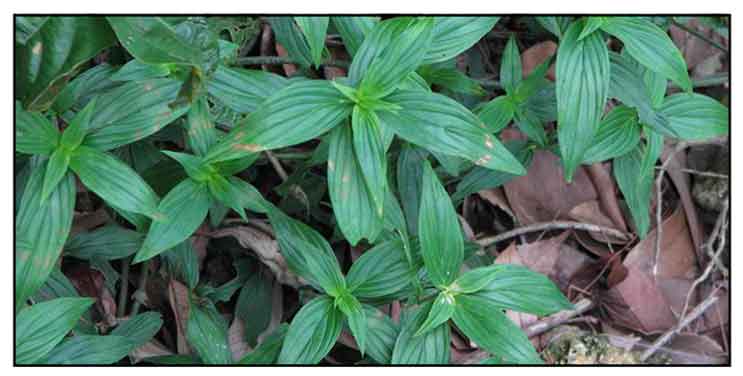
Family • Rubiaceae
Hedyotis costata
Exallage cristata (Willd.) Nandikar & K.C.Kishor
Ma er cao
| Scientific names | Common names |
| Exallage costata (Roxb.) Bremek. | No common names found |
| Exallage cristata (Willd.) Nandikar & K.C.Kishor | |
| Exallage lineata (DC.) Bremek. | |
| Hedyotis caerulea (Blume) Korth. | |
| Hedyotis capituliflora Miq. | |
| Hedyotis costata (Roxb.) Kurz | |
| Hedyotis vestita R.Br. G.Don | |
| Matabolos caeruleus Blume | |
| Matabolos lineatus DC. | |
| Oldenlandia caerulea (Blume) Kuntze | |
| Oldenlandia costata (Roxb.) K.Schum. | |
| Oldenlandia vestita (R.Br. ex Don) Drake | |
| Spermacoce costata Roxb. | |
| Spermacoce cristata Willd. | |
| Hedyotis costata (Roxb.) Kurz is a synonym of Exallage cristata. | |
| Exallage cristata (Willd.) Nandikar & K.C.Kishor is an accepted species. KEW: Plants of the World Online | |
| Other vernacular names |
| CHINESE: Ma er cao. |
Botany
Distribution Studies Availability |
Update June 2025 / June 2020 / March 2017
Updated November 2015
![]()
 |
| PHOTOS / ILLUSTRATIONS |
| IMAGE SOURCE: Hedyotis costata / Subject Database of China Plant /http://www.naturemuseum.net/album/ShowPhoto.aspx?photoid=2671c974-77ca-44f9-b304-0f16660a06f7> / click on image to go to source pages / Helixcn |
| OTHER IMAGE SOURCE: Hedyotis costata / © Jingxin Liu / Non-commercial use / Click on image or link to go to source pages / Virboga: The Virtual Botanic Garden |
| Additional
Sources and Suggested Readings (1) Traditional Chinese medicine for treating atrophic rhinitis / CN 103006933 A (2) Exallage cristata / KEW: Plants of the World Online (3) Hedyotis / Wikipedia (4) Rubiaceae: Exallage cristata / Co's Digital Flora of the Philippines (5) The Hedyotis-Oldenlandia complex (Rubiaceae: Spermacoceae) in Asia and the Pacific: Phylogeny revisited with new generic delimitations / Suman Neupane, Steven Dessein, Timothy J Motley et al / TAXON, 2015; 64(2): pp 299-322 / DOI: 10.12705/642.8 (6) Exallage / Wikipedia |
• |
DOI: It is not uncommon for links on studies/sources to change. Copying and pasting the information on the search window or using the DOI (if available) will often redirect to the new link page. (Citing and Using a (DOI) Digital Object Identifier) |
| List of Understudied Philippine Medicinal Plants |
| New plant names needed The compilation now numbers over 1,500 medicinal plants. While I believe there are hundreds more that can be added to the collection, they are becoming more difficult to find. If you have a plant to suggest for inclusion, native or introduced, please email the info: scientific name (most helpful), local plant name (if known), any known folkloric medicinal use, and, if possible, a photo. Your help will be greatly appreciated. |
• |
 |



